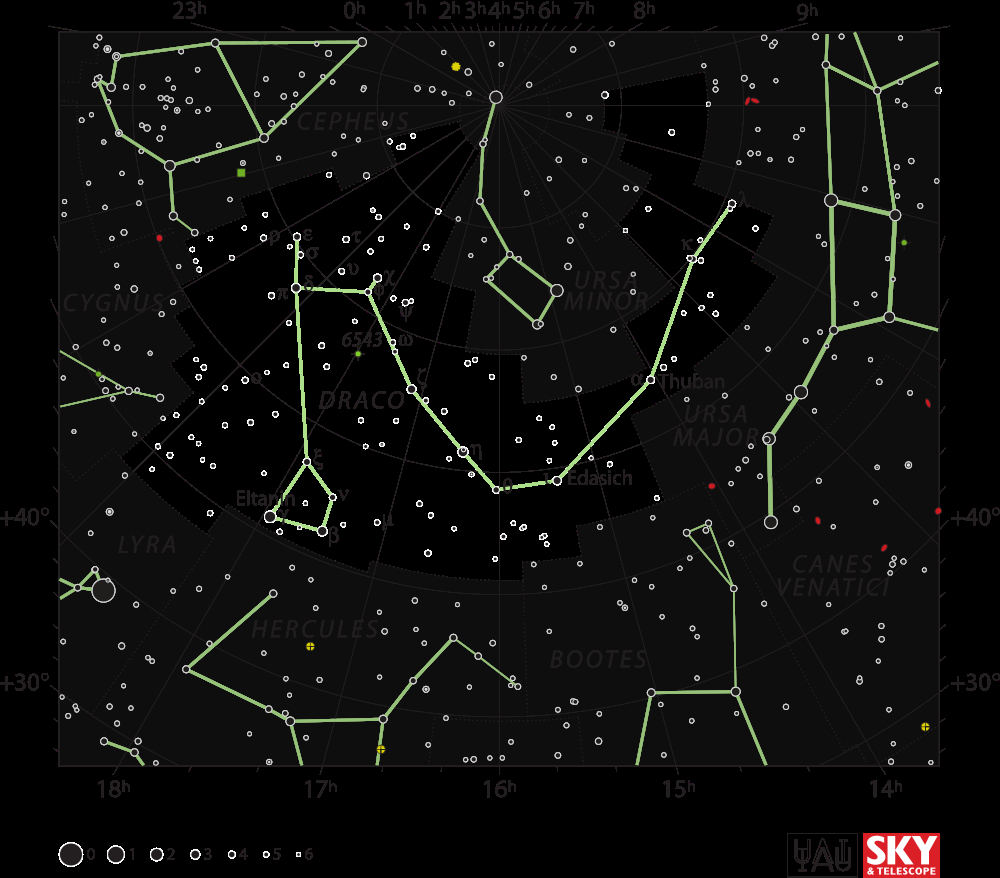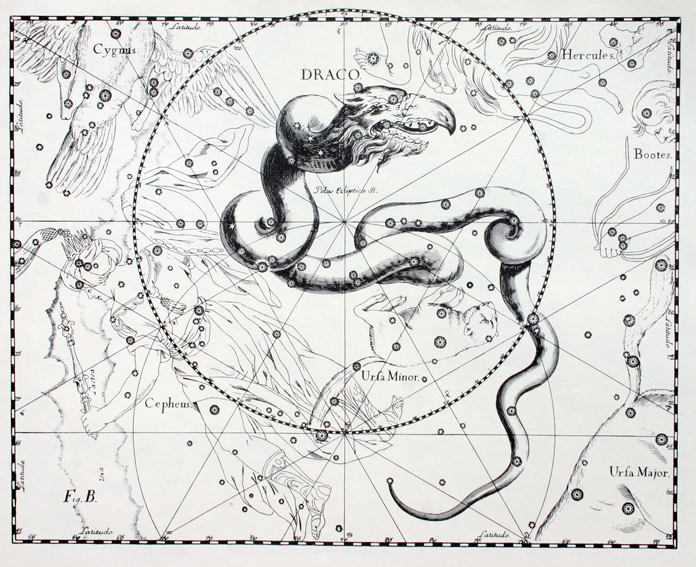
By IAU and Sky & Telescope magazine (Roger Sinnott & Rick Fienberg) [CC-BY-3.0], via Wikimedia Commons
"The Dragon"

By IAU and Sky & Telescope magazine (Roger Sinnott & Rick Fienberg) [CC-BY-3.0], via Wikimedia Commons
Abbreviation: Dra
Genitive: Draconis
Constellation family: Ursa Major
Nearest constellations: Boötes, Camelopardalis, Cepheus,
Cygnus, Hercules, Lyra, Ursa Major, and Ursa Minor
Right ascension: 17.75h
Declination: 62.51°
Visible between latitudes: +90° and -15°
Square degrees: 1083
Luminary: Eltanin (Gamma Draconis)
Named stars: Eltanin, Rastaban, Altais, Grumium
Notable deep sky objects: NGC 5866 (Spindle Galaxy), NGC 6543 (Cat's Eye Nebula), Draco Dwarf Galaxy
Draco is a large constellation in the Northern Hemisphere that is best seen in July.
Draco used to include the pole star—the star closest to the North Pole—but due to Earth's precession, or Earth's "wobble" along its axis of rotation, the pole star is now Polaris, which is located in Ursa Major. Draco will be home to the pole star again in the year 20346, since precession is a cyclical process that occurs over thousands of years.

By Johannes Hevelius [Public domain], via Wikimedia Commons
Another star of note is Draco's luminary Gamma Draconis, or Eltanin. In 1.5 million years, Eltanin will pass by the Solar System at a relatively close distance of 28 light years; by that point it will have increased in brightness to rival Sirius (from Canis Major), which is currently the brightest star in the night sky.
Draco is the origin point of the Draconid meteor shower, which occurs every year in October and peaks around October 7-8. The Draconids are sometimes called the Giacobinids, since the comet that causes the meteors is 21P/Giacobini-Zinner.
In Greek mythology, Draco represents Ladon, a dragon with one hundred heads that guarded golden apples of immortality. The apples were given to Hera, wife of Zeus, on her wedding day, and she used the dragon to protect the tree on which they grew. The dragon was killed by Hercules (also known by the Greek name of Heracles) as one of his twelve labors.
NGC 6503 (dwarf spiral galaxy):

By ESA/Hubble and NASA [CC-BY-3.0], via Wikimedia Commons
UGC 10214 (spiral galaxy also known as the Tadpole Galaxy):

By NASA, H. Ford (JHU), G. Illingworth (USCS/LO), M. Clampin (STScI), G. Hartig (STScI), the ACS Science Team, and ESA [Public domain], via Wikimedia Commons
NGC 6786 and LEDA 62867 (interacting galaxies):

By NASA, ESA, the Hubble Heritage (STScI/AURA)-ESA/Hubble Collaboration, and A. Evans (University of Virginia, Charlottesville/NRAO/Stony Brook University) [Public domain], via Wikimedia Commons
NGC 6543 (Cat's Eye Nebula):

By X-ray: NASA/CXC/SAO; Optical: NASA/STScI [Public domain], via Wikimedia Commons
NGC 5866 (Spindle Galaxy):

By NASA, ESA, and The Hubble Heritage Team (STScI/AURA) [Public domain], via Wikimedia Commons